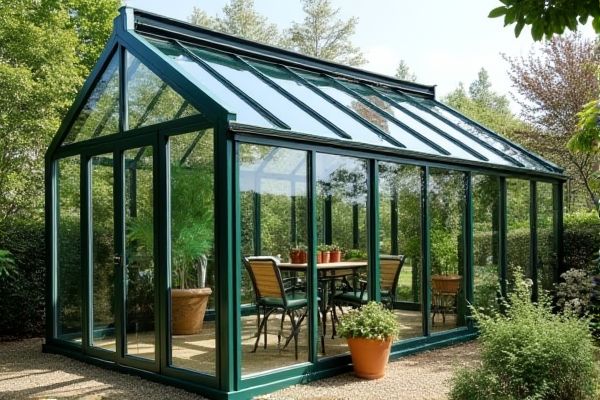
Glass greenhouses offer superior clarity and aesthetic appeal, allowing maximum sunlight penetration for your plants, while polycarbonate greenhouses provide enhanced durability, better insulation, and resistance to impact and weather conditions. Discover which greenhouse type best suits your gardening needs by exploring the detailed comparison in this article.
Table of Comparison
| Feature | Glass Greenhouse | Polycarbonate Greenhouse |
|---|---|---|
| Material | Tempered or annealed glass | Multi-wall or twin-wall polycarbonate sheets |
| Light Transmission | 90-95% natural light | 80-90% natural light |
| Durability | Fragile, prone to breakage | Impact-resistant and shatterproof |
| Insulation | Low thermal insulation | High thermal insulation, reduces heat loss |
| Weight | Heavy, requires strong frame | Lightweight, easier to install |
| Cost | Higher initial cost | Lower initial cost |
| Lifespan | 20-30 years with proper maintenance | 10-15 years, may yellow over time |
| UV Protection | Standard glass usually no UV coating | UV resistant coating included |
| Maintenance | Requires frequent cleaning and repairs | Low maintenance, easy to clean |
Overview of Glass and Polycarbonate Greenhouses
Glass greenhouses provide superior light transmission, promoting optimal photosynthesis, while polycarbonate greenhouses offer enhanced durability and impact resistance due to their multi-wall construction. Glass structures maintain traditional aesthetics and are highly transparent but can be fragile and expensive to replace, whereas polycarbonate panels retain heat more efficiently and resist UV damage, making them energy-efficient and long-lasting. Your choice depends on balancing clarity and thermal performance with budget and maintenance needs.
Material Composition and Structure Comparison
Glass greenhouses are constructed from tempered or laminated glass panels that offer high light transmission of up to 90%, providing excellent clarity and natural sunlight for optimal plant growth. Polycarbonate greenhouses use double or triple-walled panels made from durable thermoplastic, which provide superior insulation with a U-value as low as 1.5 W/m2K, reducing heat loss and energy costs. Your choice between these materials impacts sunlight diffusion, thermal performance, and durability, with glass excelling in transparency and polycarbonate offering better impact resistance and thermal efficiency.
Light Transmission and Quality
Glass greenhouses provide superior light transmission, allowing up to 90% of natural sunlight to penetrate, which promotes optimal plant growth and photosynthesis. Polycarbonate greenhouses, while offering slightly lower light transmission at around 80-85%, diffuse light more evenly, reducing hotspots and minimizing plant stress. Both materials impact light quality differently, with glass favoring direct sunlight intensity and polycarbonate enhancing diffuse light distribution for uniform crop development.
Heat Retention and Insulation Capabilities
Glass greenhouses provide excellent light transmission but have lower heat retention due to single-pane construction, causing greater heat loss during cold nights. Polycarbonate greenhouses feature double or multi-wall panels that trap air for superior insulation, significantly enhancing heat retention and reducing energy costs. The improved thermal efficiency of polycarbonate materials makes them ideal for year-round growing in cooler climates.
Durability and Maintenance Requirements
Glass greenhouses offer excellent clarity and resistance to UV rays but are more fragile, prone to breakage, and require regular cleaning to maintain optimal light transmission. Polycarbonate greenhouses provide superior impact resistance, withstand extreme weather conditions, and feature built-in UV protection, significantly reducing maintenance needs. Their double or triple-wall construction enhances durability and insulation, making them a low-maintenance, long-lasting option for year-round growing.
Cost Analysis: Initial and Long-Term Investment
Glass greenhouses typically require a higher initial investment due to the cost of durable glass panels and reinforced framing but offer superior light transmission and longevity, reducing the need for frequent replacements. Polycarbonate greenhouses have a lower upfront cost, with panels that are lightweight and impact-resistant, but may require periodic panel replacement every 5-10 years, impacting long-term expenses. Your choice should consider both the upfront budget and the expected maintenance costs to optimize investment over time.
Impact on Plant Growth and Health
Glass greenhouses offer superior light transmission, allowing plants to receive natural sunlight that promotes photosynthesis and healthy growth, while polycarbonate greenhouses provide better insulation, maintaining consistent temperatures that support plant health in varying climates. The UV protection in polycarbonate reduces the risk of plant damage from harsh sunlight, enhancing resilience and growth quality. Your choice depends on optimizing light exposure and temperature control for the specific needs of your plants.
Weather Resistance and Safety
Glass greenhouses offer excellent clarity and durability but are more prone to breakage during severe weather events such as hailstorms or heavy winds. Polycarbonate greenhouses provide superior impact resistance and flexibility, making them safer and more weather-resistant against extreme conditions. Additionally, polycarbonate panels offer better insulation while reducing the risk of injury from shattered glass.
Aesthetic and Design Flexibility
Glass greenhouses offer a classic, transparent appearance with excellent light transmission, enhancing aesthetic appeal and creating a visually striking garden feature. Polycarbonate greenhouses provide greater design flexibility due to their lightweight, impact-resistant panels that can be molded into various shapes and sizes. The choice depends on whether a traditional, elegant look or a modern, versatile structure is preferred.
Choosing the Right Greenhouse for Your Needs
Glass greenhouses offer superior light transmission and a classic aesthetic, making them ideal for growing delicate plants that require maximum sunlight. Polycarbonate greenhouses provide better insulation, impact resistance, and durability, which help maintain stable temperatures and protect plants from harsh weather. Choosing the right greenhouse depends on your climate, budget, and the specific needs of your plants to optimize growth and efficiency.
 homyna.com
homyna.com